Overview
This article serves as a comprehensive guide for mastering the creation and interpretation of histograms in Power BI, underscoring their critical role in data analysis and decision-making. By outlining essential requirements and advanced techniques, it provides key insights for effectively visualizing data distributions. Such capabilities are vital for organizations aiming to elevate their business intelligence efforts.
Introduction
In the realm of data analysis, histograms emerge as essential tools that convert raw numerical data into insightful visualizations. As organizations increasingly depend on Business Intelligence (BI) to steer their strategic decisions, mastering the creation and interpretation of histograms in Power BI is vital. This article explores the mechanics of histograms, emphasizing their significance in visualizing data distributions, identifying trends, and enabling informed decision-making.
By integrating advanced techniques and underscoring the importance of data cleanliness, readers will learn to harness the full potential of histograms in their analytical pursuits, ensuring they remain competitive in today’s data-driven landscape.
Understanding Histograms in Power BI
A bar chart serves as a powerful visual tool, organizing numerical values into defined intervals to effectively demonstrate the frequency distribution of quantitative information. In Power BI, the powerbi histogram enables users to visualize how information is spread across different intervals, simplifying the recognition of trends, outliers, and the overall distribution shape. This capability is essential for informed decision-making and strategic planning in any information-driven organization, particularly as businesses strive to harness the power of Business Intelligence (BI) to enhance operational efficiency and growth.
In contrast to bar charts, which depict categorical information, frequency distributions focus on continuous data, making them particularly valuable for statistical analysis. The ability to generate and analyze graphical data representations is crucial for professionals aiming to leverage BI and AI solutions effectively, especially in a landscape where the multitude of AI options can complicate decision-making. However, challenges such as poor master information quality can impede the effectiveness of these tools, underscoring the necessity for organizations to address information quality issues to fully capitalize on their BI initiatives.
Recent trends in information visualization underscore the growing significance of bar charts in 2025, as organizations seek to extract actionable insights from their data. For instance, a case study involving Colorado’s public libraries demonstrated how cleaning and analyzing operating hours information led to the creation of a chart that displayed the average weekly hours each library is open. This visualization not only revealed trends in library usage but also highlighted the need for improved information grouping for clarity, as the initial chart required modifications to enhance readability.
Experts emphasize that bar charts are indispensable in business intelligence, providing a clear depiction of information distributions that empower analysts to make informed decisions. As Sarah Lee noted, it is vital to equip analysts and researchers with the knowledge and resources to experiment with and integrate these techniques into their projects. Furthermore, customized AI solutions can assist organizations in navigating the complexities of information examination, ensuring they can effectively utilize tools such as charts to enhance operational effectiveness.
Moreover, programming languages like R and Python play a crucial role in information evaluation, offering robust tools for statistical computing and automation that enhance BI capabilities. As organizations increasingly adopt advanced data analysis techniques, the importance of graphical representations in identifying trends and informing strategies will continue to grow, reinforcing the need for high-quality master data to support effective AI adoption.
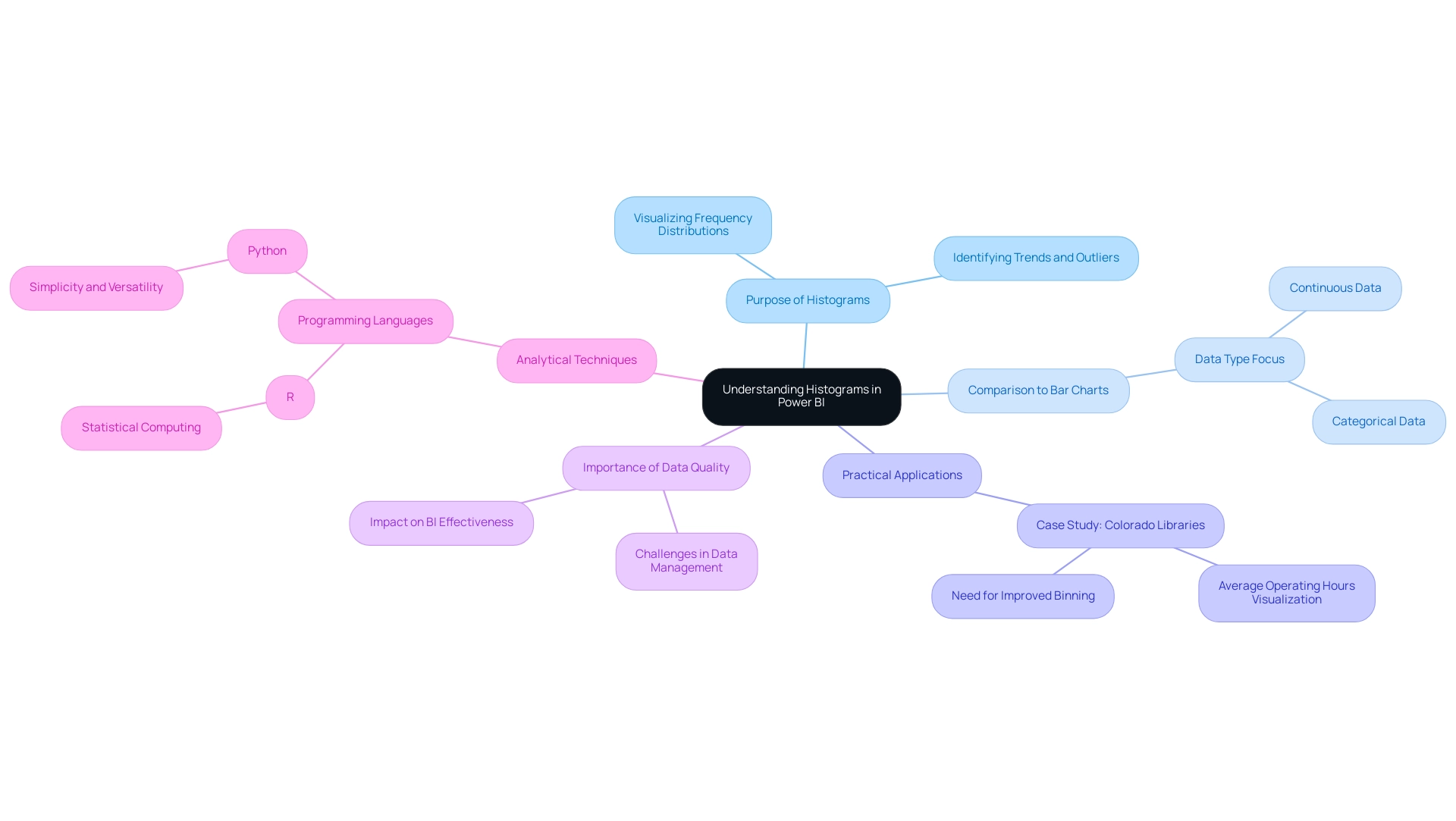
Essential Requirements for Creating Histograms
To successfully create a histogram in BI, it is essential to meet the following requirements:
-
Latest Version of Power BI Desktop: Ensure that you have the most recent version of Power BI Desktop installed. The 2025 update introduces enhanced features that improve user experience and functionality, making it easier to create visualizations.
-
Prepared Dataset: A dataset containing numerical values for analysis is necessary. This dataset can be sourced from various platforms, including Excel spreadsheets, SQL databases, or cloud-based services. Proper dataset preparation is crucial; as Annika Baumhecker notes, fostering a culture of data usage is vital for effective analytics, particularly in ensuring data cleanliness.
-
Familiarity with Power BI Interface: A basic understanding of the Power BI interface is necessary. Navigating the report view and accessing the visualization pane will simplify the chart creation process. Information Cleanliness: Ensure your information is clean and well-formatted. Errors or discrepancies in your dataset can significantly affect the reliability of your graphical representation. Organizations that prioritize information cleanliness often see improved outcomes in their analysis. For instance, in the insurance industry, the transition from outdated systems to modern analytics solutions has enabled companies to enhance service delivery and focus on data-driven decision-making.
-
Understanding of Chart Requirements: Familiarize yourself with the specific criteria for creating effective charts in BI. This includes knowing how to define bins and ranges for your information, which is essential for accurate representation. Expert Insights: Seek advice from BI specialists regarding dataset preparation for histograms. Their insights can guide you in organizing your information effectively to achieve the best results. Adoption Trends: As of 2025, a significant percentage of organizations are utilizing Power BI for information examination, reflecting its growing importance in the business intelligence landscape. This trend is driven by the increasing demand for self-service BI and real-time analytics, underscoring the need for robust information governance and security measures. Investing in information examination abilities is essential, particularly given that the average yearly salary for a business intelligence analyst in 2023 was $74,071, emphasizing the worth of skilled professionals in this area. Robotic Process Automation (RPA): Consider integrating RPA solutions to automate repetitive tasks related to information preparation and report generation. This can improve operational efficiency and enable your team to concentrate on interpreting insights instead of being hindered by manual processes.
By ensuring these requirements are fulfilled, you will be well-prepared to create informative Power BI histograms, ultimately boosting your information examination capabilities. The integration of AI-driven analytics and automation further emphasizes the importance of effective analysis techniques in today’s business environment. Additionally, consider utilizing our 3-Day BI Sprint at Creatum GmbH, designed to help you create professional reports and focus on actionable insights, thereby overcoming common challenges in report creation and data inconsistencies.
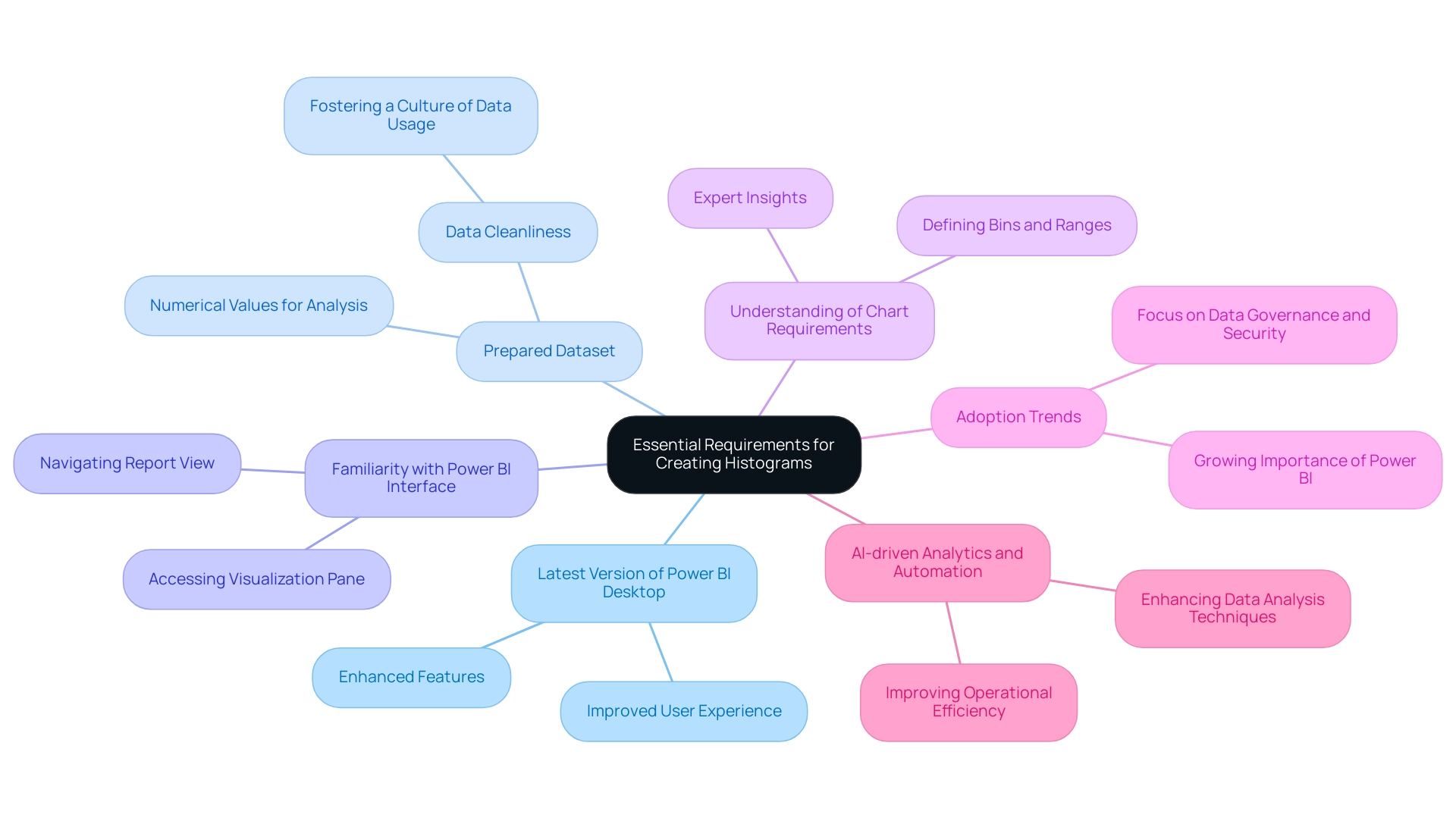
Choosing the Right Dataset for Your Histogram
When selecting a dataset for your histogram in Power BI, it is crucial to consider several key criteria to ensure effective analysis:
-
Relevance: The dataset should directly align with the analysis objectives. For instance, if the goal is to analyze sales performance, the dataset must include pertinent sales figures, ensuring that the insights drawn are actionable and relevant to business strategies. This relevance is crucial in an information-rich environment where leveraging Business Intelligence can transform raw information into insights that drive growth and innovation.
-
Numerical information is essential for creating a Power BI histogram, as histograms are designed to visualize frequency distributions. Ensure that your dataset comprises continuous numerical values, as this will facilitate accurate representation of the distribution. The quality of this numerical information is critical, as it directly influences the effectiveness of your evaluation.
-
Sufficient data points enhance the effectiveness of a Power BI histogram as the size of the dataset increases. A minimum of 30 information points is recommended to achieve a meaningful analysis. Larger datasets provide a clearer picture of trends and variations, enhancing the reliability of the insights derived. This is especially significant in overcoming challenges such as inconsistencies that can arise from smaller datasets.
-
Data Segmentation: If your dataset contains categorical variables, consider dividing the information to create bar graphs for different categories. This method enables comparative examination, uncovering insights that might not be obvious when considering the information as a whole. By utilizing RPA solutions from Creatum GmbH, businesses can automate the segmentation process, improving efficiency and reducing the time spent on report creation.
In 2025, the significance of choosing the appropriate dataset for Power BI histogram evaluation cannot be overstated. Businesses utilizing numerical information effectively can create insightful visualizations that drive informed decision-making. For example, a study examining the correlation between parental income and college GPA demonstrated how relevant datasets can yield statistically significant insights, highlighting the relationship between income levels and academic performance.
This case study emphasizes the necessity of careful dataset selection in achieving meaningful results, as statistical tests can determine the significance of correlation coefficients, reinforcing the importance of dataset relevance.
Specialists in data analysis stress that the quality of numerical information is essential in graph creation. As Abhinav Kumar observes, “Inferential statistics allow us to make predictions and test hypotheses about entire populations based on sample information,” which directly pertains to the importance of choosing suitable datasets for graphical representation. Additionally, integrating time series evaluation can improve forecasting abilities, enabling companies to make informed choices based on historical trend information.
By following these standards, you can enhance the efficiency of your chart evaluation in BI, ultimately promoting operational effectiveness and strategic decision-making. Unlock the power of Business Intelligence with Creatum GmbH’s solutions to navigate these challenges effectively.
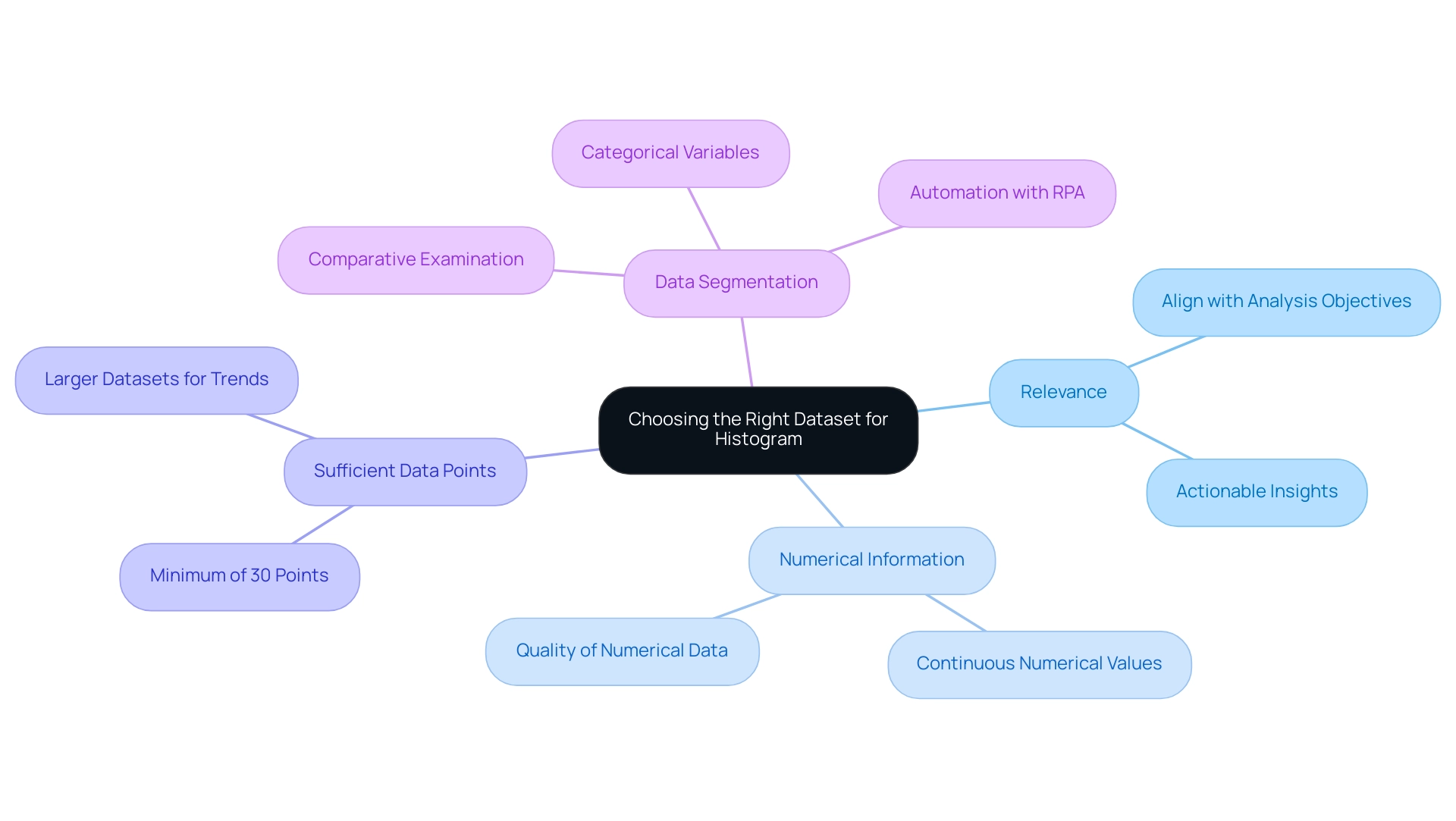
Step-by-Step Guide to Creating a Histogram in Power BI
Generating a Power BI histogram is a straightforward process that can significantly enhance your analytical capabilities, especially when leveraging Business Intelligence and RPA for operational efficiency. Follow these steps to effectively visualize your data distribution:
-
Open Power BI Desktop: Begin by launching Power BI Desktop. Load your dataset by clicking on ‘Get Data’ and selecting the relevant source, such as a CSV file containing your fiscal year information, which includes columns like Rep Name, FY-Q (fiscal year and quarter), Quota, and Attainment.
-
Select the Report View: Navigate to the report view by clicking on the report icon in the left sidebar. This view enables you to create and customize your visualizations, addressing the common challenge of time-consuming report creation.
-
Create Bins for Your Information: To analyze your numerical data, right-click on the relevant field in the Fields pane. Select ‘New Group’ to create bins, defining the bin size that best categorizes your information. This step is crucial for effective distribution analysis, allowing you to group values meaningfully and mitigate inconsistencies.
-
Add a Clustered Column Chart: From the Visualizations pane, select the ‘Clustered Column Chart’ visual. Drag your newly created bins into the Axis area and the count of values into the Values area. This configuration lays the foundation of your chart, enabling you to visualize the occurrence of points across the defined bins.
-
Format Your Chart: Customize your chart to enhance readability and presentation. Adjust colors, labels, and titles to ensure that the visualization clearly communicates the data insights. A well-formatted chart not only improves the user experience but also aids in identifying trends and outliers effectively, which is essential for data-driven decision-making.
-
Analyze Your Histogram: After creating your histogram, take time to analyze it. Look for patterns, trends, and outliers that can provide valuable insights into your data. Power BI histograms are particularly beneficial for statistical evaluation, assisting you in making informed choices based on the distribution of visualized information.
Integrating frequency charts into your BI reports can greatly enhance your analytical skills. As highlighted in the case study titled ‘Use Cases for Histograms,’ the use of Power BI histogram visual representations is advantageous for distribution examination and outlier identification, offering statistical insights that can bolster decision-making. Organizations that have effectively integrated graphical representations in Business Intelligence, alongside RPA solutions from Creatum GmbH, have reported improved data-driven decision-making processes and operational efficiency.
As you master these techniques, consider the user satisfaction rates linked to BI’s chart features, which continue to evolve and enhance in 2025, ensuring a robust tool for data examination. As Jingwei Li, a Graduate Research Assistant at Stony Brook University, remarked, “ProjectPro is an awesome platform that helps me gain extensive hands-on industrial experience with a step-by-step walkthrough of projects,” underscoring the importance of practical learning in mastering BI techniques.
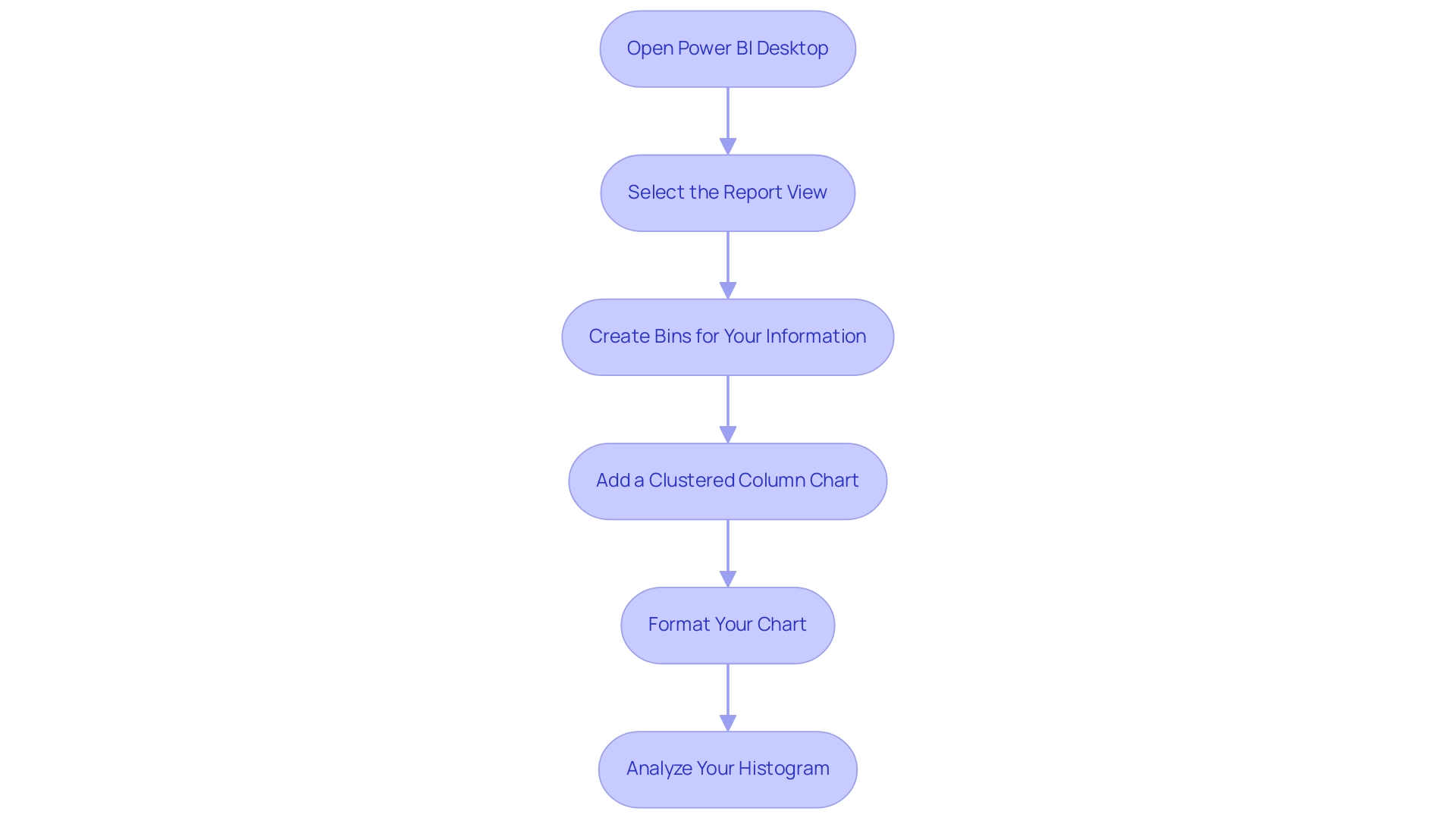
Advanced Techniques: Overlapping Histograms and More
To elevate your histogram analysis in Power BI, consider implementing the following advanced techniques:
-
Overlapping Charts: Utilize overlapping charts to effectively compare distributions across various categories. By employing distinct colors for each Power BI histogram and adjusting transparency settings, you can create a visually compelling representation that highlights differences in distributions, addressing challenges posed by poor master quality.
-
Dynamic Binning: Implement dynamic bin sizes that automatically modify based on the range of values. This approach ensures a more precise depiction of data distributions, allowing for better insights and interpretations, which is crucial for overcoming barriers to AI adoption in your organization.
-
Incorporating Reference Lines: Enhance your charts by adding reference lines for key metrics such as mean, median, or other significant values. These lines provide essential context, enabling viewers to quickly grasp the distribution’s characteristics and make informed decisions, thus leveraging insights from the Power BI histogram effectively.
-
Leveraging DAX Measures: Employ DAX measures to create calculated fields that enrich your Power BI histogram’s analytical capabilities. For instance, cumulative frequency distributions can be generated to provide deeper insights into trends and patterns, which is vital for driving insight-driven conclusions and operational efficiency.
-
Understanding Skewness: Acknowledging the skewness of your information is essential for effective evaluation. For example, a project for an environmental agency revealed that daily air quality readings often produced a left-skewed distribution, underscoring the importance of understanding distribution shapes in decision-making processes. This corresponds with the results from the case study titled “Importance of Understanding Skewness for Professionals,” which highlights that mastering skewness prepares individuals to confront challenges in interpreting information.
-
Current Trends: In 2025, the use of overlapping histograms is gaining traction in business analytics, as they allow for nuanced comparisons that traditional histograms may overlook. Statistical tests for skewness, such as D’Agostino’s K-squared test and the Jarque-Bera test, are increasingly employed to validate visual observations and guide the selection of appropriate statistical methods. For example, the median response time for customer service inquiries was 6 minutes, whereas the average response time was 8 minutes, highlighting the importance of evaluation in improving operational efficiency.
By mastering these advanced techniques, you can significantly improve your information evaluation skills using a Power BI histogram, driving growth and innovation within your organization. Furthermore, integrating Business Intelligence and Robotic Process Automation can help address the challenges of inconsistent, incomplete, or inaccurate data, ultimately leading to improved decision-making and a competitive advantage.
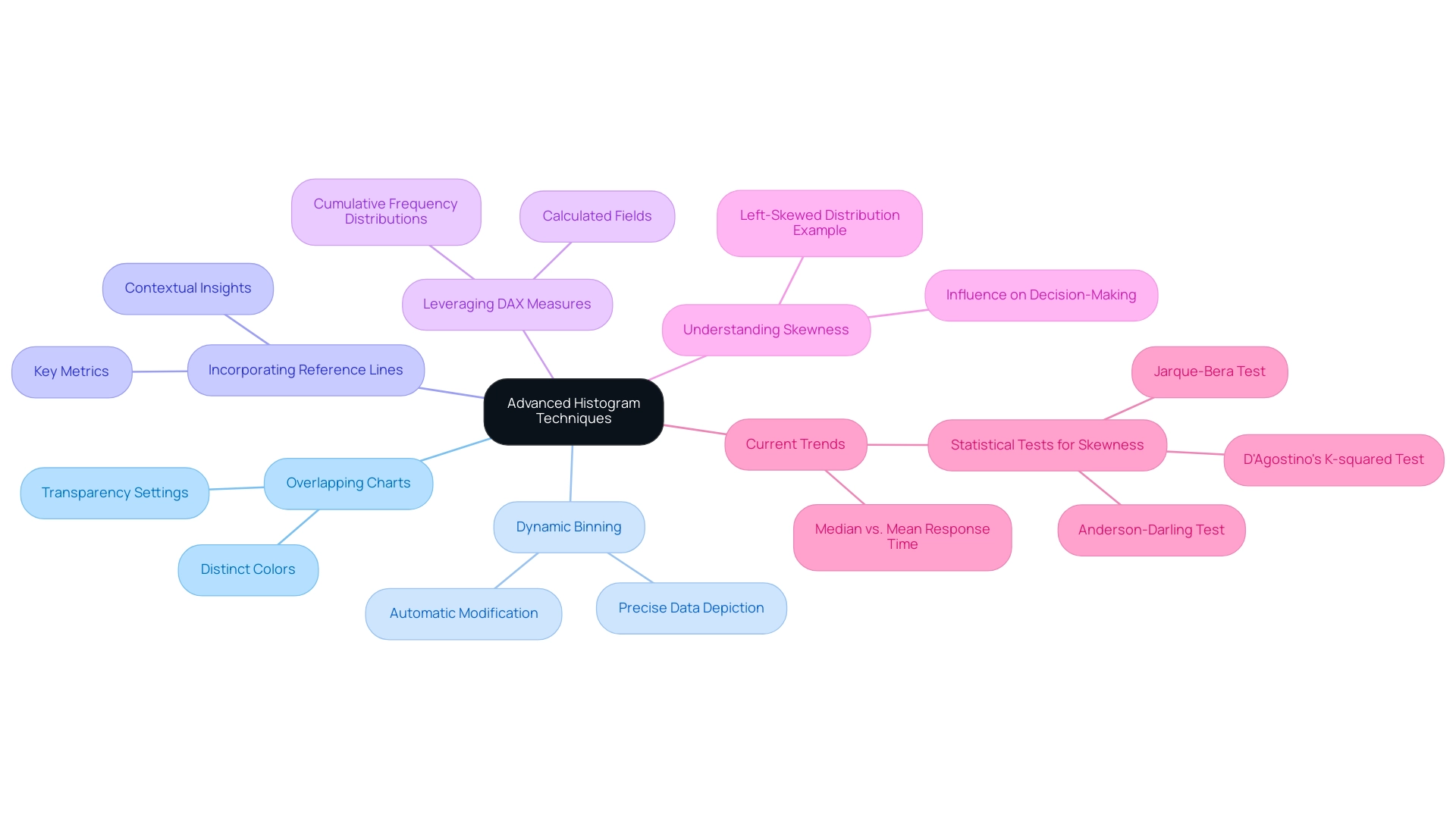
Interpreting Your Histogram: Key Insights and Analysis
Interpreting a histogram effectively necessitates a thorough analysis of its shape, spread, and central tendency, particularly in the context of leveraging Robotic Process Automation (RPA) and Business Intelligence for operational efficiency.
Shape of the Distribution: Begin by examining the shape of the data representation. Is it symmetrical, skewed to the left or right, or does it exhibit multiple peaks (bimodal or multimodal)? Comprehending the shape can uncover significant patterns within the information, such as the presence of subgroups or trends that may not be immediately apparent. This insight is crucial for organizations aiming to automate manual workflows and enhance decision-making processes.
Spread of Information: Evaluate the width of the chart to assess the information’s spread. A wider histogram suggests greater variability, indicating that the points are more dispersed. This variability can provide insights into the consistency of the dataset and highlight areas that may require further examination, especially when utilizing RPA to streamline information collection and reporting.
Central Tendency: Identify where the majority of values cluster. This is typically represented by the tallest bars in the histogram, which indicate the most frequently occurring values. Grasping central tendency is vital for making informed choices based on the information, particularly when using tools like the Power BI histogram to convert raw information into actionable insights.
Outliers: Pay attention to any bars that stand apart from the rest or are significantly lower than their neighbors. These outliers can skew your analysis and may require additional investigation to understand their impact on the overall dataset. RPA can assist in identifying and addressing these anomalies efficiently.
In 2025, organizations are increasingly utilizing Power BI histogram to examine information distribution and central tendency. A recent study highlighted that nine sources reported frequent misinterpretations concerning the use of bar charts for presenting information from two variables, underscoring the importance of selecting the suitable visualization technique. As noted by Pastore, Lionetti, & Altoè, “For researchers using statistics, graphing is a logical first step in analyzing quantitative data—for instance when looking at the distribution of univariate data—and is often advised to do before calculating a measure.”
This emphasizes the importance of utilizing bar charts in information analysis. Furthermore, it is essential to acknowledge the limitations of histograms; they are not appropriate for categorical variables or when the variable of interest is not continuous. By mastering these techniques in BI, businesses can convert raw information into actionable insights, driving operational efficiency and informed decision-making, particularly through the integration of RPA solutions.
Moreover, organizations that fail to leverage insights driven by information risk falling behind their competitors, making it essential to automate manual workflows and address challenges such as time-consuming report creation and inconsistencies.
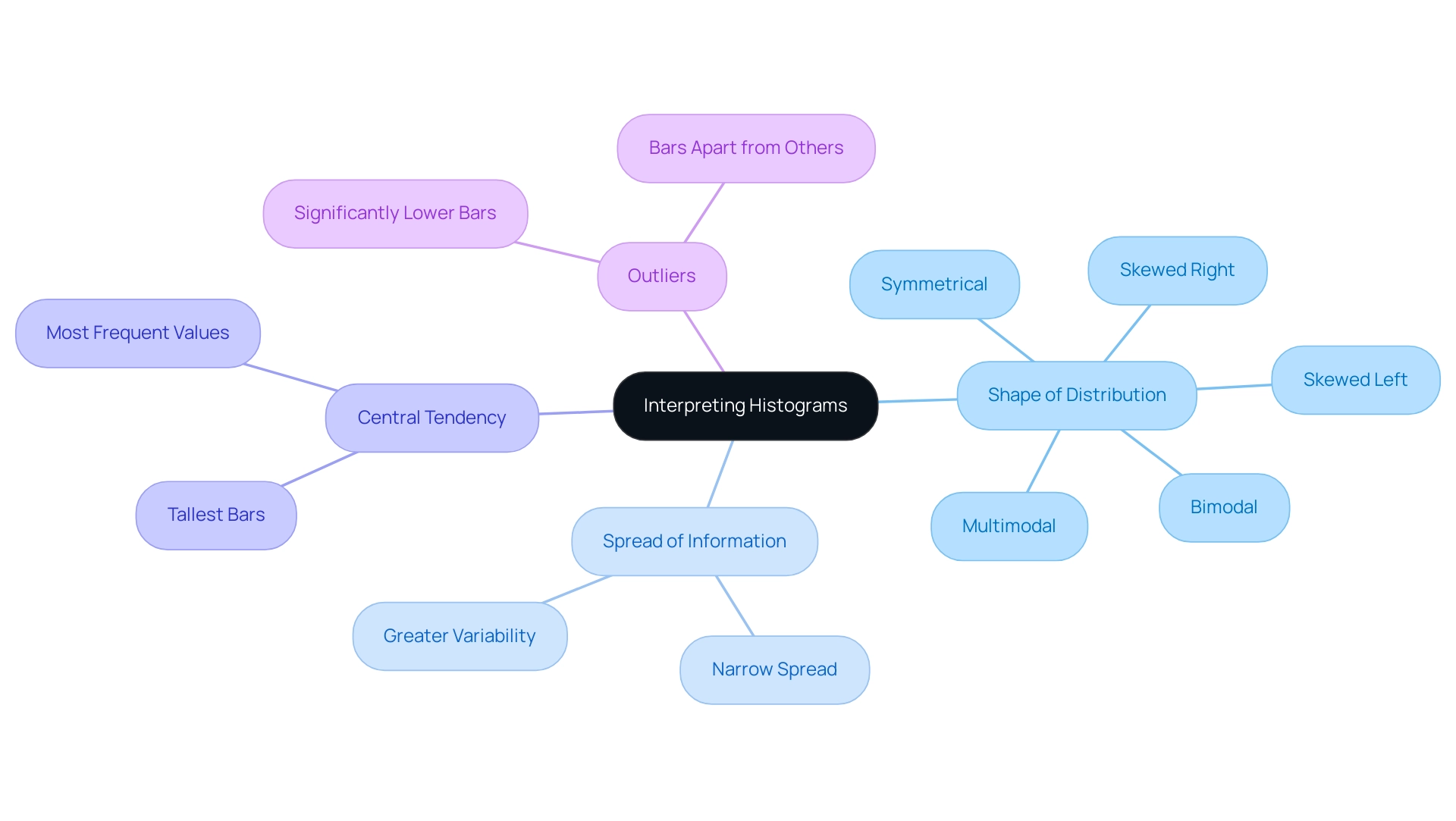
Key Takeaways and Next Steps in Power BI Histogram Mastery
Mastering Power BI histograms is essential for effective analysis, serving as powerful instruments for visualizing distributions and revealing trends. In today’s information-rich environment, leveraging Business Intelligence and RPA solutions like EMMA RPA and Power Automate is crucial for transforming raw information into actionable insights that drive growth and innovation. Here are the key takeaways for 2025:
- Histograms are vital for visualizing data distributions, enabling analysts to swiftly identify patterns and anomalies—critical for informed decision-making.
- Selecting and preparing the right dataset is essential for effective analysis, ensuring that insights drawn are accurate and actionable. However, challenges such as time-consuming report creation and inconsistencies can hinder this process.
- Utilizing advanced methods can significantly enhance the analytical capabilities of your charts, fostering a deeper understanding of the information and addressing the absence of actionable direction often encountered in BI dashboards.
- Analyzing the outcomes of bar charts is crucial for informed decision-making, as it provides a clear view of underlying trends, ultimately enhancing operational efficiency.
Next steps for improving your Power BI data analysis skills include:
- Practicing chart creation with diverse datasets to gain hands-on experience.
- Exploring advanced techniques such as overlaying multiple Power BI histograms or integrating them with other visualization tools to enrich your analysis.
- Continuously refining your skills through training and staying updated on current trends in BI, as the landscape evolves rapidly.
Statistics reveal that effective information visualization is paramount; the human brain processes visual stimuli in just 13 milliseconds and manages 400 billion bits of information per second. This underscores the need for clear and impactful visual representations in decision-making. Furthermore, organizations that have mastered visualization tools, such as Power BI, report significant improvements in operational efficiency. For instance, a case study involving a CRM tool demonstrated a remarkable 998% ROI and a 44% increase in sales productivity through effective data visualization.
As noted by the Mercedes-Benz team, “This has become a game-changer for the automotive industry, making real-time tracking possible and easy to manage.” By focusing on mastering data distributions and leveraging RPA solutions, businesses can unlock similar efficiencies and drive growth. Additionally, incorporating inferential analysis techniques, such as hypothesis testing and regression analysis, can further enhance the analysis of Power BI histograms.
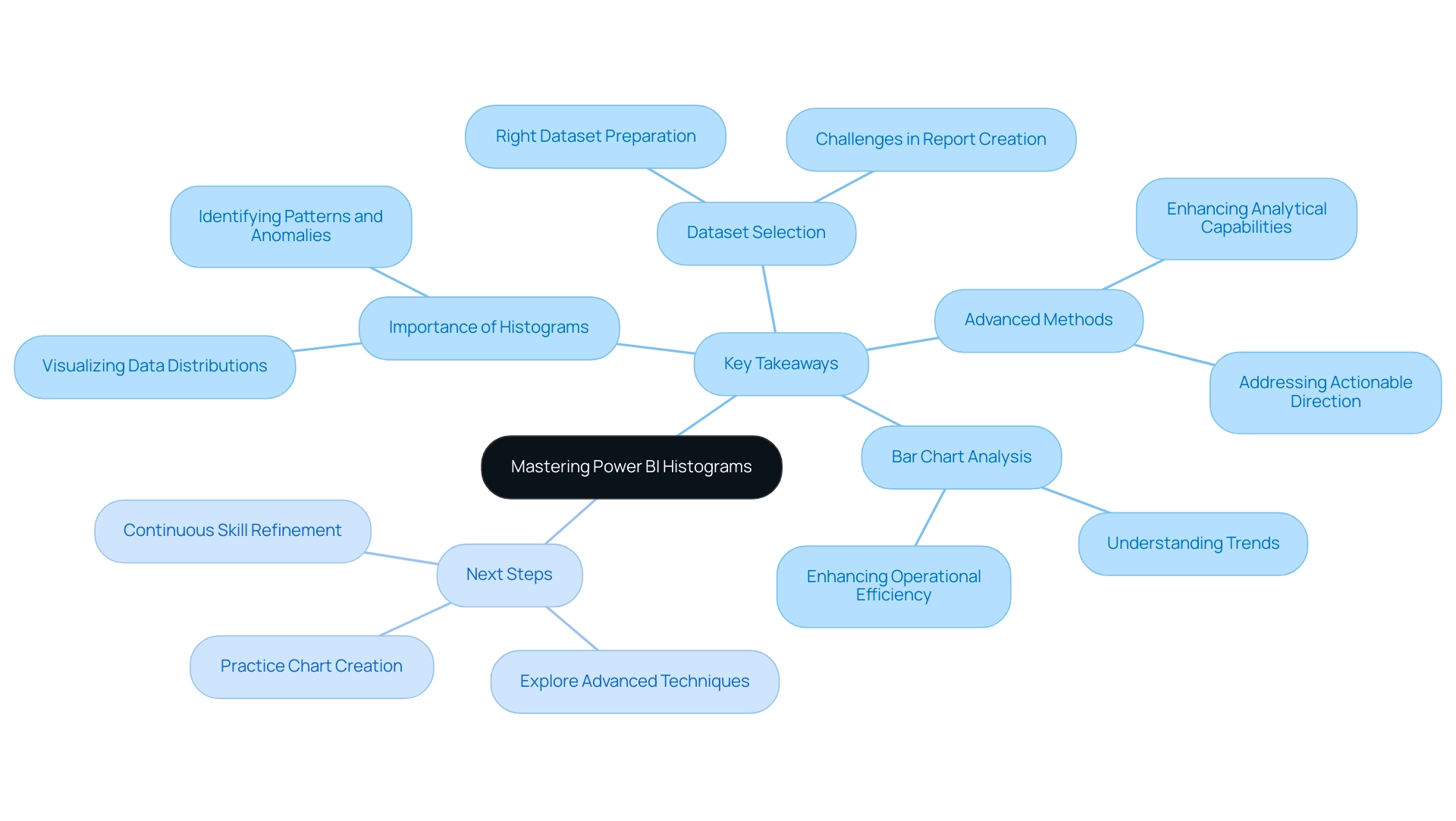
Conclusion
Histograms serve as indispensable tools in the realm of data analysis, particularly within Power BI, where they transform numerical data into clear visual representations of frequency distributions. This article underscores the importance of mastering histogram creation and interpretation, especially as organizations increasingly depend on Business Intelligence to inform their strategic decisions. By grasping the mechanics of histograms—including the significance of data cleanliness and the necessity for relevant datasets—analysts can extract valuable insights that drive informed decision-making.
Furthermore, advanced techniques such as overlapping histograms, dynamic binning, and the incorporation of reference lines significantly enhance the analytical capabilities of histograms, enabling deeper insights into data trends. The ability to effectively interpret these visualizations—by examining shape, spread, and central tendency—reinforces their critical role in identifying patterns and anomalies vital for operational efficiency.
As organizations navigate the complexities of data analysis in 2025, integrating histograms into their BI strategies becomes essential for sustaining a competitive edge. By prioritizing data quality, embracing advanced analytical techniques, and continuously refining their skills, professionals can unlock the full potential of histograms in Power BI. Ultimately, mastering these visual tools not only facilitates improved decision-making but also cultivates a culture of data-driven insights that can propel businesses toward growth and innovation.
Frequently Asked Questions
What is a bar chart and how is it used in Power BI?
A bar chart is a visual tool that organizes numerical values into defined intervals to demonstrate the frequency distribution of quantitative information. In Power BI, it helps users visualize how information is spread across different intervals, aiding in the recognition of trends, outliers, and the overall distribution shape.
How do bar charts differ from histograms?
Bar charts depict categorical information, while histograms focus on continuous data and frequency distributions. This makes histograms particularly valuable for statistical analysis.
Why is it important for organizations to focus on information quality when using BI tools?
Poor master information quality can impede the effectiveness of BI tools. Organizations need to address information quality issues to fully capitalize on their BI initiatives and enhance operational efficiency.
What recent trends have been observed in information visualization for 2025?
There is a growing significance of bar charts as organizations seek to extract actionable insights from their data. For example, a case study involving Colorado’s public libraries showed how cleaning and analyzing operating hours information led to valuable visualizations.
What are the essential requirements for creating a histogram in Power BI?
The requirements include having the latest version of Power BI Desktop, a prepared dataset with numerical values, familiarity with the Power BI interface, understanding chart requirements, and ensuring information cleanliness.
How can organizations improve their data analysis capabilities?
Organizations can enhance their data analysis capabilities by fostering a culture of data usage, ensuring information cleanliness, seeking expert insights, and considering the integration of Robotic Process Automation (RPA) for automating repetitive tasks.
What is the significance of programming languages like R and Python in BI?
R and Python provide robust tools for statistical computing and automation, enhancing BI capabilities and helping organizations adopt advanced data analysis techniques.
What are the implications of the increasing demand for self-service BI and real-time analytics?
The trend reflects the necessity for robust information governance and security measures, as organizations increasingly rely on tools like Power BI for effective information examination.

